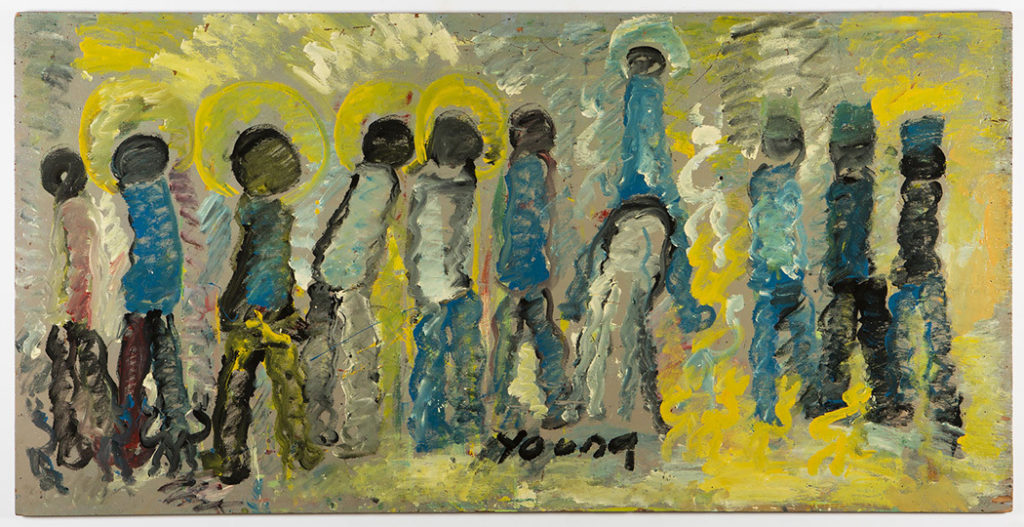Since his paintings began making their way north out of the Overtown ghetto of Miami in the 1980s, Purvis Young (1943–2010) has been referred to by a variety of epithets worthy of a character in Homer: Purvis the visionary, Purvis the outsider, Purvis the political activist, Purvis the obsessive, Purvis the intuitive-untrained-graffiti-folk artist, or my favorite of all, Purvis the “biblical figuralist.” (Everyone who met him, by the way, quickly warmed to calling this friendly bear of a man by his first name.) With exhibitions of some of his paintings now in two Manhattan galleries, it’s time to drop the qualifiers and finally call Young a significant artist.
Young’s first works appeared on the street, directly on walls and tethered to chain-link fences in his neighborhood, only later to hang in galleries and museums.
Young’s first works appeared on the street, directly on walls and tethered to chain-link fences in his neighborhood, only later to hang in galleries and museums. In this way, his art followed a similar trajectory as that of certain well-known street artists of the same period—namely Keith Haring and Jean-Michel Basquiat, though his stardom never rose as high. More importantly, however, in the same manner as Haring and Basquiat, Young invented a completely arresting, utterly original iconography recognizable from across the room or the tracks—a visual language charged with specific, incendiary meaning and all the shadowy mysteries he took to the grave.
Now, in two exhibitions, at James Fuentes LLC and Salon 94 Freemans on the Lower East Side, Young’s signature sylph-like figures, made from one or several elegant strokes of black paint, allude to faceless bodies in an overcrowded, sweltering urban backdrop.1 Young repeats the gesture again and again, in painting after painting, having his subjects dance, march, mourn, tote their enormous burdens, and suffer, but also play—on their own or around and about his other imagery, covering the homemade surfaces he used with tireless movement.
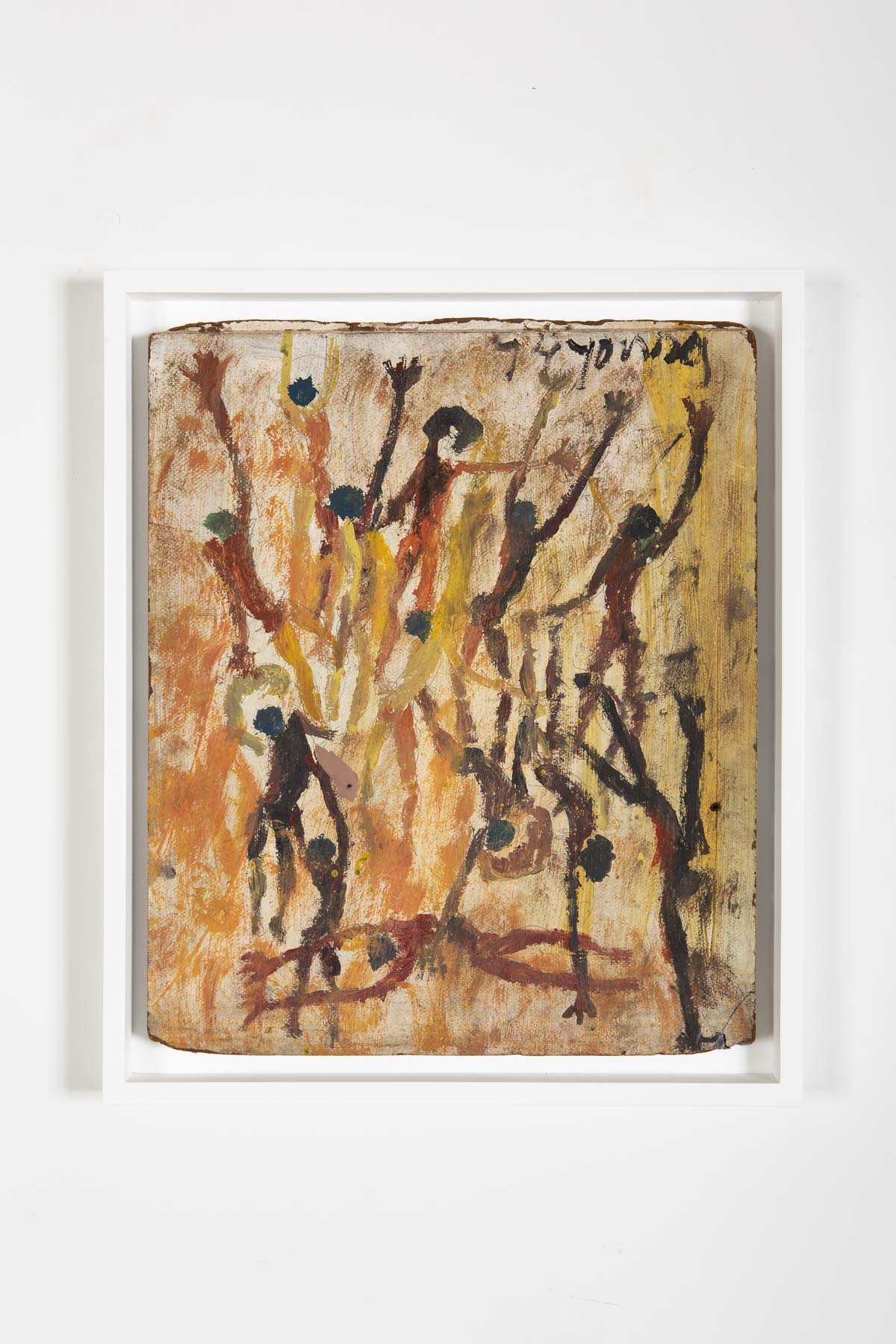
At Salon 94, Untitled (Crowd) (1974) depicts a tangle of these bodies, some with arms stretched to the sky in praise or a kind of “Hands up!” surrender, others falling or lying trampled underfoot, the lot of them surrounded or consumed by a sea of orange and ochre flames. As gutting and enthralling as a Goya engraving, the painting emanates anxiety, discomfort, and complete powerlessness. In Untitled (1992), a standout painting of the Fuentes show, Young enlarges the figures and walks them in tight, organized rows, one line to the left and another above to the right, in a snaking chain, some on horseback, the whole parade trudging and wafting up into the sky.
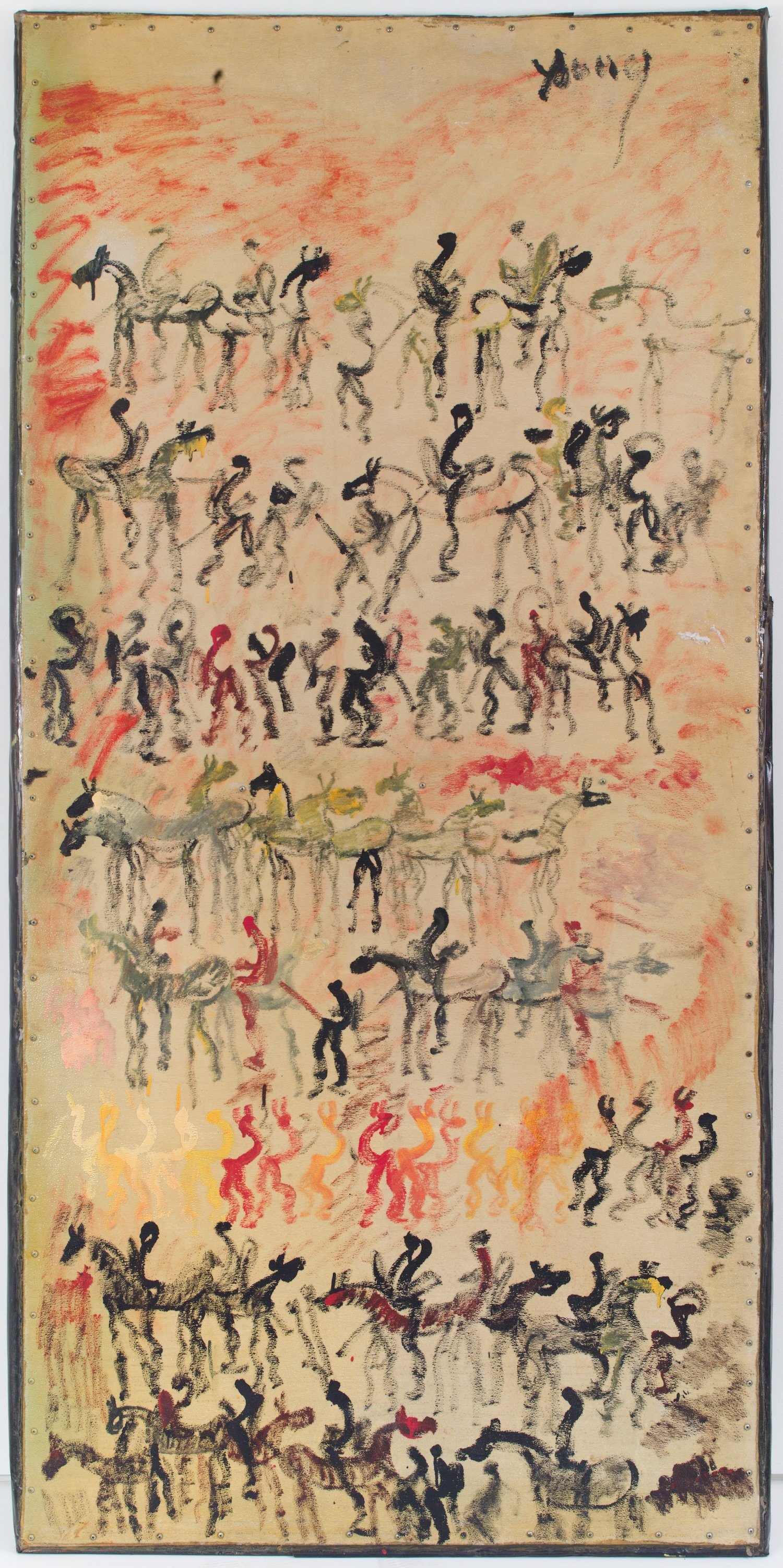
With these dabs of his brush Young seems to represent the African Americans of his community—mostly invisible and anonymous to people living elsewhere in his city and country, except to those who see them from speeding cars on Expressway 836. Untitled (Crowd) and Untitled pay witness, to be sure, but also exist as rich, transfixing compositions executed by a practiced hand. In other paintings these figures, in queues or jumbled groups, carry on their heads—reminiscent of the caricatures of African porters in 1950s safari movies—everything from tractor trailers and a church to hypodermic needles. Given the speed and confidence with which Young painted, many works feel almost “automatic” in a quasi-Modernist style. Often using brushes full of cheap but radiant house paints he picked out of the garbage, Young’s most successful works vibrate with a nearly spiritual energy, like Baroque altarpieces.
Since he rarely titled his work, there has always been a temptation to interpret and label Young’s paintings more specifically than the artist himself chose to do.
Horses appear in many of Young’s paintings, executed with a lively ease similar to that of his human figures. Sailing ships also feature frequently, along with silhouettes of pregnant women; enormous, oval faces (some suggestive of the ever-serene Buddha), which Young called his “angels”; and monster cockroaches that crawl over his city’s cinder block dwellings. These images, and their stagings, live somewhere between the conscious and unconscious: surreal urban landscapes that captured and haunted Young’s imagination for five decades. There is celebration in some paintings as well; Young himself was an open-hearted, generous man despite a four-year stint for robbery in a state penitentiary as a teenager and a life lived in poverty. One of the most alluring of Young’s paintings at Salon 94—mistitled, I believe, Untitled (Funeral Procession) (1996) by a former owner—depicts a joyous parade blazing with brilliant yellows and turquoise blue, likely that of Jesus entering Jerusalem on Palm Sunday.
Since he rarely titled his work, there has always been a temptation to interpret and label Young’s paintings more specifically than the artist himself chose to do, as much for marketing and cataloging purposes as for pleasure. Another stunning work at Salon 94 is called Untitled (5 Basketball Players) (ca. 1980s); but the fact that he often rendered images of slaves from the back of their heads as simple black circles like those dominating this particular work, along with the appearance of a horse in the painting, leads me to believe it’s not a basketball game at all, but a slave auction.
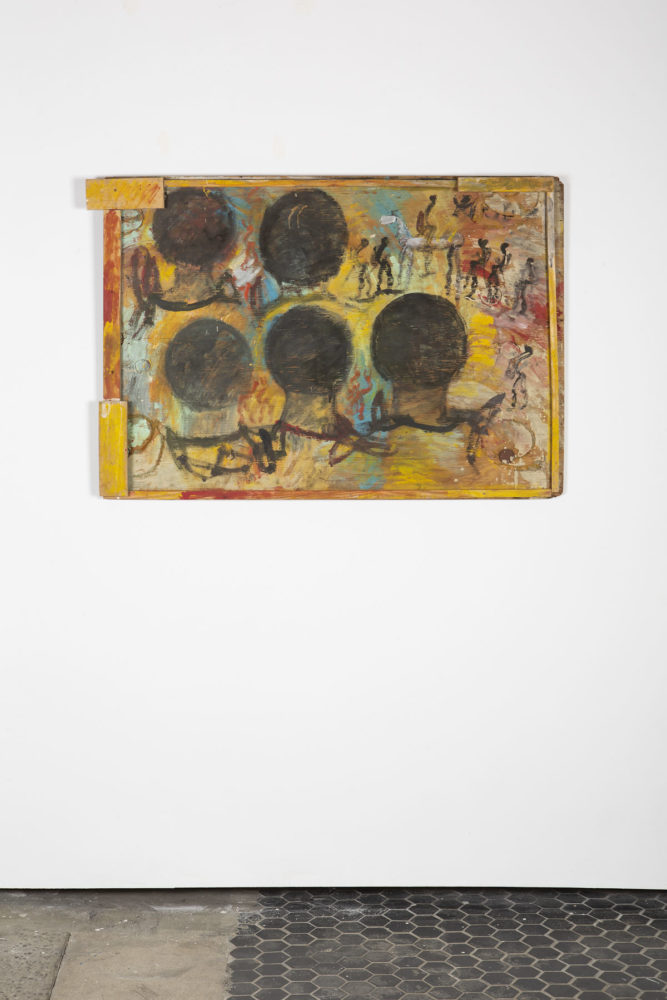
During his lifetime, Young chafed at the idea that he over-produced when dealers used to suggest he slow down. The Rubell family bought 3,400 pieces of his work in 1991, and his court-entangled estate supposedly comprises another three thousand, not to mention the thousands sold to others by the artist and various galleries. The extraordinary size of his body of work remains an honest reflection of the man himself—how he spent his days and how he absorbed and made sense of the world. (In 1978, he cogently titled a book of drawings This Is My Life. I See It Every Day.) No one else has ever expressed and recorded the quotidian practice of a paint-obsessed artist the way that Robert Ryman did, but Young, in his own way, did something similar.
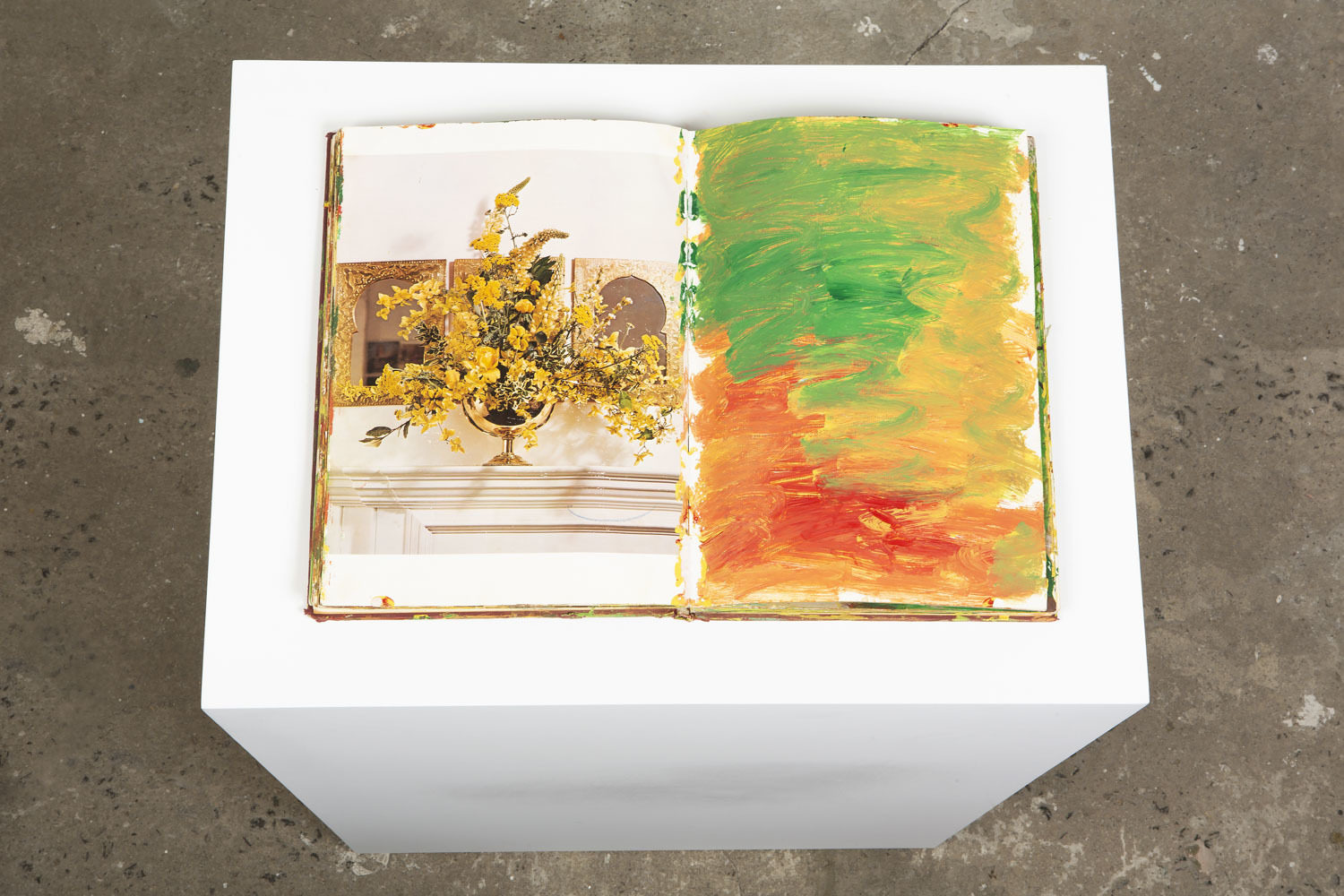
When I visited Young in 1986, his storefront studio in Overtown (formerly known as Colored Town) resembled a cross between a sultan’s cave of priceless treasures and a hoarder’s hideaway. Stacks of his finished paintings leaned twelve deep in the tiny room. Alongside the paintings sat piles of the books he repurposed, their bindings bursting with calligraphic renderings of the same imagery he painted, drawn or pasted over the original texts. His work resided elbow to elbow with its raw materials, which basically amounted to so much junk. Discarded doors he found on the street, sections of plywood ripped from demolition sites, scraps of carpet and strips of lashing for his frames, and warped and water-stained pressboard all teetered head-high in a claustrophobic jam, waiting for his alchemy. (Even when he made some money from his work he stuck faithfully to this mixed media.) Thirty-three years later, I see Young as a magician capable of transforming these heaps of detritus into timeless objets d’art.
